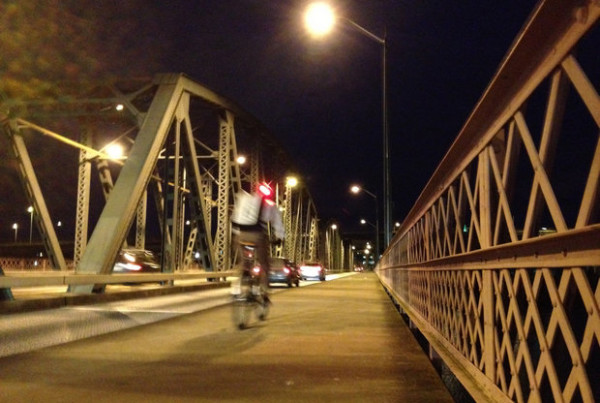The North County News: Loch Raven biking debate shifts into high gear
City, cycling enthusiasts vow to revamp trail pact
By Jay R. Thompson, jthompson@patuxent.com
Posted 12/15/09
A meeting this week at Baltimore’s City Hall worked to ease tensions between city officials and bicyclists over trail restrictions around Loch Raven Reservoir.
“It was a productive meeting,” said Penny Troutner, owner of Light Street Cycles in Federal Hill and a cycling enthusiast at Loch Raven.
Troutner and other representatives of the biking community met with Mayor Sheila Dixon and other officials Dec. 14 and vowed to work toward revamping a 1998 agreement on trail usage — which bikers say only recently has been enforced.
“The problem is … that there is a sudden enforcement of a policy from 10 years ago,” said Jim Miller, of Anneslie, noting that the city has been more insistent in recent weeks that bikers stick to “two-track” fire roads — those trails large enough for four-wheel vehicles.
“I’ve been riding there since before that plan was in place,” Miller said. “There’s been no visible change until a few weeks ago.”
In recent weeks, three riders were issued $100 citations by Watershed Rangers when they were caught riding after dark in the reservoir area, and bikers have expressed the fear that trail use might be curtailed or eliminated.
Last week, the city’s Department of Public Works sought to dispel those rumors, issuing a statement Dec. 10 that the rumor about prohibiting biking is “unfounded,” and that, “the only citations issued were to three bikers who were in the woods at night.”
But the statement also said that due to bikers’ expanding use of trails, “Vegetation has been destroyed, trees damaged, ramps built and the resulting erosion is threatening our drinking water supply.
“Our watershed lands are not parks, and have never been parks,” the statement said.
The 1998 policy was created when a city Mountain Biking Task Force — composed of Department of Public Works officials and members of area mountain biking groups — developed a plan to allow biking on the city-owned properties of Loch Raven, Prettyboy and Liberty reservoirs.
The three reservoir properties have about 52 miles of approved, two-track biking trails — 29 miles at Liberty, 12 at Loch Raven and 11 at Prettyboy.
The trails the Department of Public Works considers off-limits are narrower roads called “one-tracks.”
On Nov. 23, the City Council passed a resolution to reopen discussions of how to allow mountain biking in the reservoir watershed without harming water quality.
The resolution noted that enforcement was being stepped up, including policies restricting mountain biking.
Kurt Kocher, a spokesman for the Department of Public Works, said one of the dangers of biking at night — and biking away from the two-tracks — is that if someone is injured, “we’d have to go out and do a search and rescue.”
Kocher said the 1998 plan states that bikers must stay on fire roads.
“Over the years, I think a lot of people have forgotten about that because we didn’t have the capacity at the time to do all the enforcement,” Kocher said.
That has changed, though. He said public works has implemented a Watershed Rangers program — dedicating personnel to enforce regulations, assist people in the watershed and monitor the state of the watershed itself.
Natural concerns
Since deployment of Watershed Rangers and passage of the Nov. 23 resolution, anxiety among bikers has grown.
Tension between bikers and city officials stems from an effort to balance recreational use of the reservoir area and protection of the city water supply.
The reservoirs supply water to more than a million people, and city officials say overuse of trails can cause erosion, destroy vegetation and affect the forest’s ability to filter pollutants from runoff before they enter the reservoir.
Erosion also sends soil and debris into the reservoirs, which reduces the amount of water reservoirs can hold.
But mountain bikers such as Miller believe they are good stewards of trails.
“Yeah, there’s a few jerks,” he said. “But we’re good stewards.”
He and his wife, Beth, have two daughters, 11 and 14, and he said he hits the trails at Loch Raven about twice a week, sometimes with company.
“Both of my girls like riding their mountain bikes in Loch Raven,” he said.
Miller thinks cyclists would be willing to work with the city, but he thinks sudden, strict enforcement is not the answer.
“A more prudent approach would be to look at the places on the trails that would have the greatest impact on the watershed,” Miller said.
He said that if the city determined certain areas are being damaged to the point of harming the reservoir, mountain bikers would be happy to help repair damaged areas.
“We could get a lot more done having two of them and 10 of us and having six work crews out there on some weekend,” Miller said.
“I don’t feel like the city has communicated what the need is,” he said.
Spokes-people
Troutner was on the task force that drafted the 1998 plan, but defends the use of one-track trails for biking.
“Fire roads — that’s not really mountain biking,” she said.
Troutner has two boys, 15 and 19, and thinks the trails are a source of quality time with children.
“Riding with your children is such a great activity,” she said. “(The reservoir is) a beautiful place … not a lot of cities have such great mountain biking.”
Stoneleigh resident Elizabeth Voss, a mountain biker of 15 years, agrees.
“My husband and I started riding together when we first met,” Voss said. Now they sometimes bring their three daughters, ages 7, 9 and 11, along.
“We’ve made it a family lifestyle,” Voss said. “A way to get them outside, away from television and video games.”
Voss even sympathizes with nighttime riders — saying they make the park safer because their presence deters people who might sneak in at night to drink, use drugs or do other illegal activities.
That said, she believes mountain bikers wouldn’t argue with enforcement against night riding.
“If that’s one of the main issues, they certainly won’t fight that,” Voss said.
Troutner said she feels the latest discussions could be an opportunity for both sides to benefit.
“If Baltimore expands its recreation activities, it will be able to attract more people and increase the tax base,” she said.
“I think this is, most of all, a really great opportunity for the city to embrace the mountain biking community — it’s a quality-of-life issue and a really important one,” she said.
And, she added, “With all the people willing to volunteer helping on trails, the city should take advantage of it so the city doesn’t have to pay for it.”
Troutner said that at Monday’s meeting with Dixon and other city officials, the working group agreed to have an updated plan finished by the end of February, and then take that revised policy to a public hearing for comment.
The public hearing date has not been set.
Kocher wouldn’t predict what might result from the future public hearing, but he insisted that a ban of mountain biking on reservoir properties is not on the table.
“No, absolutely not,” he said. “There’s no anticipation for any kind of ban out there.”

